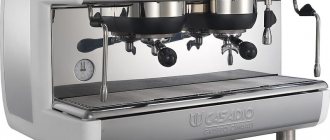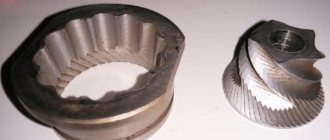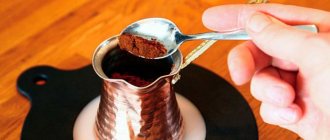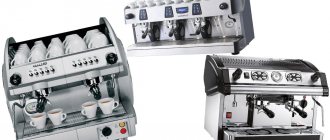Rules for choosing a name for a coffee shop
If you don’t know where to start choosing the name of an establishment, then think over the basic principles from which you can build in the future:
- The name should reflect the main concept of the establishment. The name conveys the peculiarity of your coffee shop, as well as its theme.
- Consider SEO. A striking example is the names of establishments that contain their own names - in this case, the search engine can only rank you at the bottom. If you name the cafe “Marina”, then the requests will include ordinary people, celebrities, etc. It is better that the name is original and not associated with a lot of things.
- The name of the establishment should be easy to remember. If it sticks in your visitors' minds, it increases the chance that they will return again. The title should be easy and soft to read.
- The cuisine of your establishment is a hook for naming. If the menu and name are opposed to each other, then misunderstandings may arise among customers.
- Before you settle on a specific option, check how the names sound in simple conversation.
- Uniqueness is not a recommendation, but a requirement. If you have a name like your competitor, this may entail a number of legal problems. It is better not to look at the names of popular coffee shops - try to come up with an original name for the coffee shop yourself or contact professionals for help.
How to choose a name for a cafe
When choosing a name, two main approaches are used: thematic and random. There are many examples in business history where a random word was chosen as a company name. This approach was implemented in the companies Apple, Mars, and Nike. The problem is that in this case the name does not work for the brand. On the contrary, the success of a brand evokes associations with the product in the audience. Unless a name has a success story behind it, it won't tell customers anything, so this approach should be used with caution.
Thematic titles allow you to effectively filter your audience and form a first impression. A name that conveys the properties of the product is ideal for beginning businessmen and small businesses.
The name of the coffee shop will influence the popularity of the establishment
Basic principles for choosing a name for a cafe:
- Use names of dishes and ingredients. The main advantage of such a sign is accuracy. It will inform customers not only that food is served here, but will also let them know whether to count on a full meal or limit themselves to a cup of coffee and dessert. A good example: the famous confectionery chain “Cinnabon” (translated as “cinnamon”). This principle was also used in, “Teaspoon”, “Almond café”, “Pizza Allegro”, etc. Good names mentioning seasonings, additives and desserts: “Caramel”, “Honey cake and coffee”, “Coffee and cream”. You can also combine them with neutral words, for example “House of Coffee”, “Planet Sushi”, etc.
- Include the word "taste" in the title. Names such as “Tasty like at home”, “Delicious coffee”, “Thirst for taste” not only communicate what the visitor can get, but also evoke positive emotions. Options for the name of the coffee shop can also involve associations with smells, such as “The Scent of Cinnamon” or “Your Flavored Coffee.”
- Use first and last names. This simple naming method is widely used in various areas of business. Such names set the mood for a homely atmosphere. And using exotic names and addresses, you can emphasize the national flavor. This approach is especially often practiced when naming confectionery shops and bakeries (“Monsieur Patissier”, “Monsieur Croissant”, “Stolle”, “F. Volchek’s Bakery”). The list of names can be expanded to include mythological characters.
- Don't be afraid of original names. As mentioned above, random words do not work for a brand, but you can combine them with more characteristic attributes: Pilgrim Coffee Shop, Pastry Shop By the Window, Three Meerkats and Coffee. Experiment and attract customers through bright solutions.
- Use geographic place names. The most obvious solution is to link to an address if the cafe is not a chain cafe. “At Five Corners”, “Beans on Gorokhovaya”, “Coffee House on Tverskaya” - simple and memorable options. Such names can also highlight the peculiarities of the cuisine and theme of the establishment (“Shanghai”, “Old Baku”, “Prague Bakeries”).
- Try phrases. This option uses a narrow market segment, so the name will be original. Examples: “Good afternoon”, “Bon appetit”, “Two coffees to go”. Experiment; as a result, you can get an effective name that simultaneously works as an advertising slogan.
Children's Cafe
You can emphasize the childish focus by using fairy tale motifs, as well as diminutive versions of words and names. Options for children's institutions can be divided into seven large categories:
- based on cartoons and fairy tales (Totosha, Umka, Fairy Tale, At Papa Carlo's);
- animals (Kangaroo, Octopus, Baby Mammoth);
- plants (Pine cone, Miracle tree);
- fruits and berries (Mandarin, Vitamin, Raspberry), as well as seasonings (Cinnamon, Pepper);
- food (BurgerKids, Macaroni);
- holidays (Birthday Boy, Happy Birthday!);
- altered words and slang (Akvamarinka, Ukhtyshka, TaRaRam);
- natural phenomena (Spark, Droplets, Star).
The name of the children's establishment should attract young customers
In addition, you can use children's names (Dasha, U Zarina).
The main thing when naming a children's cafe is not to overdo it with diminutives (they often look funny and awkward) and to avoid complex words that are difficult for children to pronounce.
Italian cafe
In establishments of national cuisine, it is customary to emphasize the theme on the sign. Hundreds, if not thousands of cafes and restaurants successfully operate in Russia with neutral names such as “Pizza and Pasta”, “Pizza Planet”, and also indicating nationality (“Italian Trattoria”). This is a good option for the low price segment, as well as for small cities with little competition, where it is important to immediately identify the features of the kitchen.
Other popular solutions:
- more or less well-known Italian words with positive meanings: Aroma (aroma), Primavera (spring), Buonissimo (excellent);
- first and last names (“Giuseppe’s Garden”, “Dinapolli”);
- geographical toponyms (“Verona”, “On Vesuvius”, “Neapolitan Breakfast”).
Eastern cuisine cafe
“Oriental cuisine” usually means the widest variety of culinary traditions of different regions: the Caucasus, the Middle East, etc. In the most general sense, this direction is distinguished by the use of a large number of spices, a variety of festive meat dishes and confectionery.
Establishments of oriental cuisine are usually named according to the same principle as other national cafes. As a rule, the owners of such establishments use in the name:
- the word “oriental” (“Oriental sweets”, “Taste of the East”);
- words of national languages (“Aksaray”, “Chito-gvrito”);
- geographical toponyms (“Bukhara”, “Samarkand”);
- names (classic “At Ashot’s” from this series);
- names of dishes and seasonings (“Master-Pilaf”, “Pilaf is ready”, “Khmeli-Suneli”);
- and also involve associations (“Bedouin”, “Tales of Scheherazade”).
Japanese
Japanese cuisine has replaced American fast food in the market and is very popular all over the world. Sushi and rolls, noodles and soups, salads and other dishes are quickly prepared, and the use of toppings and sauces provides a variety of flavors.
Japanese establishments are gaining popularity every year
A list of names for a Japanese cafe might include:
- names of dishes (“Planet Sushi”, “Sushi Terra”);
- geographical names (“Osaka”, “Tokyo City”);
- associations (“Samurai”).
When coming up with a name, you should consider the target audience. In a big city, a name like "Kyoto Prefecture" has the ability to be read unmistakably, but the further from the center, the less the average visitor knows about the nuances of Japanese geography and culture. In a small town or village, the banal but understandable “Sushi rolls” will look perfect. This, of course, does not apply to the border regions of the Far East.
French
French cuisine has had such an influence on Russian cuisine that many of its dishes have organically entered our daily menu. Broths, puree soups, salads and pates - we owe all this to France. In addition, the French are considered the standard in the field of baking. The names of French dishes are widely known and easily recognized, so they are used especially widely (“Béchamel”, “Cruton”, “Camembert”). As well as geographical names (“Parisian coffee house”, “Provencal corner”).
Confectionery
French motifs dominate the names of confectionery shops: “Croissant”, “Marzipan”, “Napoleon”, “Praline”. Also popular are references to Viennese traditions (“Vienna Workshop”), as well as names of dishes (“Waffels”, “Cheesecake”, “WaffleYogurt”, “Good Cake”, “Pretzel”). In general, when naming confectionery shops, you can lower your imagination and attract the whole palette of associations associated with the feeling of pleasure. “Sladostory”, “Sweetlovers”, “Mint Donut”, “Secrets and Buns” - all these names will help the visitor relax and want to buy something truly tasty.
Fast food cafe
For fast food cafes, many people use English-language names that refer to well-known fast food chains. “PelmenHouse” and “McClaren” may not look very nice in terms of originality, but they are quite recognizable and evoke unambiguous associations with fast food.
You can emphasize the speed of service by using appropriate words. If “Minutka” is found in almost every city and even district, then names like “Flash”, “Racer”, “Sprint Roll” look original and involve associations with speed.
Brands that include the name of a restaurant's main dish work great for recognition and setting expectations. In combination with other words and phrases, interesting options are obtained, for example, “Those same donuts,” “Khinkali from the heart,” “Kroshka Potato.”
The name should indicate the characteristics of the coffee shop
Roadside cafe
In a roadside cafe, the main thing is to focus on drivers passing by at high speed. In this regard, a large “Shashlyk” sign may be more advantageous than an intricate name, behind which a potential buyer does not recognize the eatery. However, fans of original naming also have something to explore:
- Use short titles. Names work great on the road (“At Palych’s”, “Alenin’s Dvor”).
- Use a road theme - from the banal “Trucker” to the more sophisticated “Pilgrim”.
- Play with geographical names (“Klin pancake”, “Tula gingerbread”).
Involve infographics. A flashing plate with a fork will attract customers no worse than the name and will free up their hands when choosing this very name.
Dining room
By giving preference to the canteen, the buyer chooses the usual “home-made” food and low prices. Therefore, the name of the canteen should reflect the specifics of the institution. Over 15 years of operation, the St. Petersburg chain “Canteen No. 1” has become a recognizable brand and attracts tourists and city residents. This is a good example of the fact that sometimes an original name is not needed, and it is better for advertisers to focus on a recognizable logo and corporate identity.
If you are sure that the name is needed, follow the proven paths:
- Use the names of dishes, seasonings, ingredients. The emphasis should be on associations with satiety and cooking: “Cheese cheese”, “Shchi-Borsch”, “Compote”.
- Use associations with home comfort: “Like mom’s,” “Home-made lunch,” “Tasty like home.” Use names that include the words "appetite", "food", "nutrition", "meal", "lunch".
- Strengthen the “cozy” impression by using a name (“At Mikhalna’s”, “IvanIvanovich”).
Kebab house
Here you can use not only the names of dishes and seasonings (“Ketchup”, “Spicy and satisfying”), but also associations with fire (“At the grill”, “Cafe-Fire”). References to Caucasian cuisine and culture (“Elbrus”, “Caucasus”) are also popular. Some cafe owners use more creative options like “Wing or Leg” or “At Your Plate.”
Coffee to go
Coffee shops have at least one advantage over other catering establishments - customers hear the smell of freshly ground and freshly brewed coffee almost before they see the sign. This is partly why you can so often come across an original name for a takeaway coffee shop that is not related to coffee at all. “Rider of Denariev”, “Give Two”, “Behind the White Rabbit”, “Place of Power”, “Farinari”, “The Hobbit” - these establishments operate successfully, despite the non-obviousness of the naming. Conclusion - the name should first of all be sonorous, biting, effective, and the smell of coffee will tell the rest.
At the same time, names that include the word “coffee” or “coffee shop” are also widely used and give room for imagination. Good examples: “Coffe Booom”, “Dr.Coffee”, “More Coffee!”, “World Coffee”, “Cult of Coffee”, etc. And if you use words and terms that are indirectly associated with the drink and the process of its preparation , the list of options for creative naming is expanding endlessly. “Baristocrat”, “Cheerful Barista”, “On caffeine”, “Brewed”, “Take and Run” - catchy and memorable names, which also leave no doubt about what is hidden under the sign.
Stages of naming a coffee shop
In order for you to be sure that you have made the right choice of the name of the establishment, you need to go through several preliminary stages of naming, which are outlined by professional marketers.
- Conduct target audience research. First, decide what kind of people you are creating a coffee shop for. Here you need to understand their approximate age, hobbies, tastes and food preferences. Based on this, you can develop a unique offer that will attract visitors. Knowing the target audience is the main factor in the success of any establishment.
- Study the market of your direct competitors. This stage is necessary to immediately dismiss the names of competitors, as well as to identify trends in the field of naming. This will also help highlight your strengths, which will help when competing in the coffee shop market.
- Conduct research on the service and brand. Here you can determine the strengths of the brand, as well as the main characteristics of the future coffee shop.
- Choose the theme and concept of the establishment. It is this stage that determines how your visitors will remember the coffee shop. Developing a concept idea is based on all the research you've done previously.
- Come up with several name options. You probably won't be able to choose the best name the first time, so generate a few ideas that come to your mind.
- Choose the most successful idea from the resulting ones. From the entire list that you obtained in the previous paragraph, choose the name that best matches your message and idea.
#3: Stonefruit Espresso
Where: 1058 Bedford Ave Brooklyn, NY
Stonefruit Espresso is a farm-to-table cafe in Brooklyn. It was this establishment that managed to combine the benefits of seasonal organic vegetables and fruits and a modern lifestyle. They serve not only coffee, but also tea, the taste of which is very different from the usual drinks that city residents buy by the liter at fast food outlets. It is worth noting the relaxed atmosphere of this coffee shop. Living in New York can be stressful enough, but people come to Stonefruit Espresso for peace. Almost half of the coffee shop is occupied by a flower shop. A cappuccino, macchiato or Americano will cost you $3-5 per cup, but believe me, it's worth it.
Ideas and name options for a coffee shop
In fact, coming up with a good name for a coffee shop from scratch is not an easy task. You can be inspired by ideas that have already stood the test of time and are successfully used by competitors. But just to get inspired - using ready-made names is ineffective and can lead to litigation from competitors. By the way, in our Anti-Franchise proposal you will not have to choose a name for the coffee shop. The name Bravos is already familiar in many cities. And if you decide to open under your own brand, we won’t mind. To receive a detailed business plan and financial model, fill out the form below:
Most coffee shops like to use a hint of coffee: “Coffeemaker”, “Coffee Maker”, “Coffee Academy”, etc.
If you want to show that, in addition to coffee, you also have a special atmosphere, then you can use a foreign name (for example, “Bon Cappuccino” positions itself as the center of Italian coffee). It is not always necessary to come up with a super-creative name, since a simple naming can be remembered much better by customers. For example, “Coffee Club” immediately tells you what you can find here.
Help from a friend
Often people close to us turn out to be much smarter and more creative than we think. Often in our environment there is a contingent that can be safely called the creative layer of the population. These could be editors, journalists, musicians and simply extraordinary people. Such individuals love brain puzzles, so we can confidently say that your friend will be happy to come up with a name for the coffee shop.
Names that evoke coffee and food
Sometimes it is not necessary to directly tell your guests that there is a coffee shop here. Inspiration for proper naming can also be found in the kitchen that this establishment has. If you include one of the signature dishes in the name, then potential guests will immediately understand the specifics and peculiarities of the coffee shop. The main thing here is that the title matches the content. Examples of such names are “Chicken Run”, “BEEF meat & wine”, “Khinkalnaya Gogi”, “Pretzel”, “Chocolate Girl”, etc. From the names it is immediately clear that the menu is in great demand here.
#1: Maman
Where: Nomad, Meatpacking, Soho, Tribeca, Greenpoint
This is not to say that Maman serves the cheapest coffee in the city. The price tag here is slightly higher than the New York average. A cup of espresso will cost you $2.5, and for a latte you will have to pay $4-4.5. But you should definitely visit this cozy establishment. When you get here, you magically find yourself in Paris. And the delicious pastries that this coffee shop serves to its beloved guests will make you add this place to your list of must-visit places in New York.
Literary name of a coffee shop (example)
Coffee shops that use this naming technique not only stand out from other establishments, but also create a special atmosphere. In recent years, more and more such establishments have appeared in large cities. This cafe is characterized by a warm and cozy atmosphere, dim lighting, and the opportunity to purchase souvenirs and books. A great place for all lovers of literature and just a pleasant pastime.
Such titles often use the names of famous literary works, characters, authors, etc. Examples of such coffee houses are Chekhov, Cheshire Cat, Pushkin, Dead Souls, 12 Chairs, Onegin, etc.
What makes a coffee shop famous?
Making coffee is a fairly profitable business, because everyone drinks it. But not all coffee shops have become famous throughout the world for their service and quality products, as did, for example, Kaffeine in London, Heart Coffee Roasters and Stumptown Coffee Roasters in Portland, The Coffee Academics in Hong Kong and some others. These places are famous for their original interior, excellent service and interesting concept. For example, to get a job at Kaffeine, a barista must train for 3 years, The Coffee Academics makes coffee with guava juice, and Stumptown Coffee Roasters brews aromatic punch for 12 hours before opening, which attracts Portland residents and visitors. Any world-famous coffee shop has 4 distinctive signs, without which any feature or zest is meaningless - excellent service, cleanliness in the hall and bar, original interior and a name, memorable and original, which is sure to attract attention.
Naming in a foreign language
English versions of coffee shop names sound stylish, modern and soft, thanks to the peculiarities of the language. This is why lately you can see a large number of coffee shop options with foreign names. This concept expands boundaries, creates a modern atmosphere for the establishment, and also attracts customers, since a foreign name is often associated with the high status of the establishment.
This is also convenient if the owner wants foreign guests to also choose his coffee shop for cozy gatherings with friends. A foreign name automatically expands the target audience for this establishment. Also, the use of English words and phrases allows you to stand out from other competitors: you can focus on the features of the cuisine, emphasize the uniqueness of the establishment and its features, and simply bring something new to its atmosphere. To make it clear even to ordinary guests that a coffee shop is located here, the name is used, which must include the word “coffee” (Espresso Bike, Craft Coffee, Bublik's Coffee, etc.). You can also encrypt in English letters the name of the owner or founder of the coffee shop - Federico & Co, Skuratov Coffee, etc. Another interesting technique is writing a Russian word using the Latin alphabet (Chashka, Onegin coffee, etc.).
Taking inspiration from names around the world
Peculiarities of naming coffee shops in the West will tell you what the owners are betting on: a beautiful name or hitting the target audience?
Study examples of foreign and domestic coffee shops to find inspiration.
To answer the question, let’s take a walk through foreign cities:
- London: Kaffeine. A coffee shop with a simple name gathers many guests in a small hall every day. The suffix in the word emphasizes coziness, miniatureness and attracts lovers of peace.
- Paris: Closerie des Lilas. The name is translated from French as “Lilac Farm”. A cult place with a long history: the terrace in the fragrant lilac attracted artists, writers, musicians - the entire capital's elite. A good example where the original name reflects the appearance
- Vein. The Landtman coffee house appeared in the 19th century and bears the name of its first owner, Franz Landtman. They serve delicious desserts and the best coffee in Vienna. The establishment changed several owners, was rebuilt, but retained the name of the creator in the title. In Russia, few people call companies by their family name, and in vain: relying on tradition is an excellent marketing ploy
- Calgary (Canada): Analog Coffee. The coffee shop's menu includes more than 20 varieties of high-quality coffee and several preparation options. For example, in a Japanese drip coffee maker, which gives the drink a special taste. Baristas use alternative methods of roasting and brewing beans. The name of the coffee shop reflects its unique feature
\ Note! Examples of foreign coffee shops are original, but reflect the peculiarity of the establishment, the interior, or are part of the concept.
What titles should you not choose?
When choosing names, you can use your imagination to the fullest, however, there are some restrictions that must also be observed when naming:
- Don't use your competitors' names. This will not only confuse consumers, but can also play a cruel joke on you. The law provides penalties for misuse of intellectual property, so be careful when choosing a name and always check if it is used by one of your competitors. Using a similar style or replacing one letter is also not the best way to stand out from your competitors.
- Don't use foreign words without knowing their meaning. Here the situation can turn out to be comical if the word that you liked by its sound means something completely different. When using a foreign language, make sure you know the translation of the phrases.
- There is no need to overdo it with originality. This is especially true for the use of abbreviations - if you shorten too many words, then customers may not even understand what kind of establishment is in front of them. Sometimes simplicity is much better than originality.
#2: Toby's Estate
Where: 125 North 6th Street, Brooklyn, New York
Toby's Estate in Brooklyn is not only a coffee shop, but a coffee school. The design of the coffee shop is made in a loft style, there is a lot of open space and seating. There was also a place for a tiny kitchen, which is open daily from 7 am to 3 pm. Breakfast and lunch are available at Toby's Estate. Try the bacon and egg roll, avocado toast, or homemade muffins made on the spot. The main advantage of the establishment is that they use products from trusted suppliers who rely on organicity and quality.
How to name a pastry shop at home: examples
Most often, foreign words are used in the names of confectionery shops. This is explained by the fact that in Russia such vocabulary always sounds beautiful. El Gusto, Belissimo, Bon Appetit - such names will undoubtedly attract attention and will not go unnoticed. People really like names that rhyme: “Sweets from Masha”, “Sushi from Andryushka” and so on. It is worth remembering that a home-made confectionery shop should not be called too pretentiously; for example, “Dostoevsky” or “Pushkin” is unlikely to do. For a home-based pastry shop, a homely, warm name is more typical, for example “Grandma’s Pies”, “Anechka”, “Aunt Olya’s Pies”.
But one rule applies to every enterprise, be it a large concern or home production: the interests of customers must be taken into account first, the confectionery must meet all SanPin requirements, and most importantly, make sure that your visitors are satisfied and leave with the firm intention of returning to you again.
#6: Sweatshop
Where: 232 Metropolitan Ave, Brooklyn, NY
Sweatshop stands out among other coffee shops in the city due to its unique atmosphere, which combines the most attractive features of an Australian cafe and the rigor of a design studio. Ryan De Remer, the store's co-founder, says the space is best described as a "thriving community hub for coffee lovers and designers." One of their most popular drinks is the Sparky, which is made with ice-cold espresso, tonic water and lime.
Coffee shops in Asia
The coffee shops here have a discreet style. Basically, like the residents themselves. For them, the most important thing in an establishment is the coffee drink, in which its strength and bitterness are most valued. For example, Damascus coffee is a huge drop of coffee slurry that needs to be licked, not drunk. This drink will immediately invigorate you and banish fatigue and drowsiness for a long time.
In Asia, it is believed that coffee is a drink only for men. While drinking, they talk and smoke hookah. Business meetings can often be seen in Turkish coffee shops. But usually, this place is intended to allow you to relax.
African coffee
While exploring the coffee shops of the world, one cannot forget about Africa. African coffee shops are distinguished by the fact that they have a special spirit and unchanging traditions. Fishawi's Coffeehouse is a classic establishment, made according to all the canons.
This coffee shop is more than 250 years old and is located in the old quarter of Cairo. This is a fairly small coffee shop with hookah smoke, a lot of huge mirrors and wooden furniture. The opening of the coffee shop was thanks to an Arab family.
For a very long time they used recipes for making coffee drinks on sand. Usually, meetings are held here by residents who just want to talk. In that century, writers, artists, and poets loved this establishment very much. They preferred private rooms that were like museums.
Tomoca Cafe is a rather interesting establishment in the capital of Ethiopia.
A coffee tree was planted in front of the entrance to the establishment and a trade exhibition was set up. This premises is the very first coffee shop to open in Addis Ababa. In this place you can always see many people wanting to taste delicious coffee. Here they serve coffee along with a sprig of grass that grows in this country. It has a bitter citrus taste and has soothing properties.
In Tunisia they like to visit establishments where there are no tables. In the center and along there are only stone benches, which were covered with mats. But in the capital there are already coffee shops that have a familiar interior for European residents.
For example, Chaouechin. This coffee shop has a beautiful interior that looks a bit like something out of a spy movie. The client may feel that something secretive and interesting is happening at the tables. But in fact, ordinary visitors gather here who want to enjoy the taste and aroma of an unearthly coffee drink.
Types of pastry shops
What do you call a pastry shop? Before answering this question, let's look at the types of these wonderful establishments. There is a home confectionery, where you make sweets yourself or with someone’s help, and a confectionery in the form of a store, where production is put on a conveyor belt. You have studied all the pros and cons of these types, and you are faced with the next question: what can you call a confectionery shop?
The answer to this question depends on the goals you set for yourself. Names can be either provocatively cheerful or cute and conservative. The final choice of the name of the confectionery depends on the concept of the establishment as a whole.
#5: Culture Espresso
Where: 72 West 38th St. New York, NY
This place is primarily known for its best flat white in town. Culture Espresso is one of those places where you want to return every day. In the summer, people most often order iced coffee with the addition of oat milk (can you imagine how much health is in one cup of coffee?). You can add a little homemade vanilla syrup to make your coffee a little sweeter. If that's not enough reason for you to head to this wonderful cafe today, their delicious chocolate chip cookies were voted number one in the annual cookie competition in 2021.











